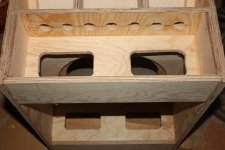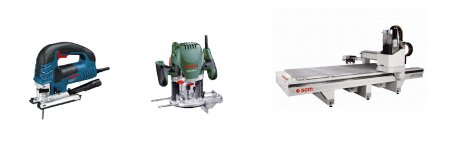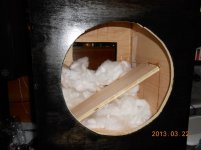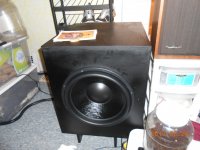Sealed vs Ported subwoofer??
I am curious what's the difference between these two.
How does a sealed sub work??
after researching this all I can find are opinions

How does this sub sound in a sealed vs ported
15" big xmax sub 25mm & 43mm Xmech
This thing looks like a Monster & better than Dayton Titanic
Stereo integrity HT 15" Dual 2 Ohm subwoofer
I am curious what's the difference between these two.
How does a sealed sub work??
after researching this all I can find are opinions
How does this sub sound in a sealed vs ported
15" big xmax sub 25mm & 43mm Xmech
This thing looks like a Monster & better than Dayton Titanic
Stereo integrity HT 15" Dual 2 Ohm subwoofer
Last edited:
"How does a sealed sub work??"
Speaker compresses the air in the box...acts as shock absorber or damper.
Could you post a synopsis of the opinions you have found...Then we can offer more opinions on those opinions (and possibly some facts).
There is a lot of information on DIYAUDIO on this subject, answering this same question.
Happy Hunting.
Speaker compresses the air in the box...acts as shock absorber or damper.
Could you post a synopsis of the opinions you have found...Then we can offer more opinions on those opinions (and possibly some facts).
There is a lot of information on DIYAUDIO on this subject, answering this same question.
Happy Hunting.
These two subs are almost identical in design and purpose. Both could be described as "universal".........what does that mean? Calculating to determine if either driver would be best used as a ported type or a sealed type...the designers have "split the difference"... Efficiency bandwidth product is a calculation to determine if it is best to port it or go with the sealed enclosure. By splitting the difference compromises have to be made....rendering the outcome mediocre at best. Both have a giant Xmax which lends itself to less than optimal performance...another compromise. Essentially the more Xmax you have the more likely you will not be getting pure linear cone movement.
Cone control gets harder & harder the more travel you get. These HT drivers are simple extensions of drivers used in the Car Sub-woofer market......that of which has been overwhelmingly dismissed as suitable for Home use.
I would look elsewhere for a suitable driver....one that has "chosen" to be used in a port or not.
___________________________________________________Rick.........
Cone control gets harder & harder the more travel you get. These HT drivers are simple extensions of drivers used in the Car Sub-woofer market......that of which has been overwhelmingly dismissed as suitable for Home use.
I would look elsewhere for a suitable driver....one that has "chosen" to be used in a port or not.
___________________________________________________Rick.........
Designed for sealed or ported...explained! - DIYMA Car Audio Forum
from a JBL engineer. You can pretty much take all of that as fact and not opinion. It is all rooted in physics. If you need to know more...
http://commonmode.blogspot.com/2008_01_01_archive.html
and if you still need to know more, pick up any college level University Physics 101 textbook and look up the chapters on damped harmonic oscillators.
from a JBL engineer. You can pretty much take all of that as fact and not opinion. It is all rooted in physics. If you need to know more...
http://commonmode.blogspot.com/2008_01_01_archive.html
and if you still need to know more, pick up any college level University Physics 101 textbook and look up the chapters on damped harmonic oscillators.
Last edited:
Don't dismiss car drivers with strong motors and huge X-Max, in the end it is all about moving air. The 18" SI is a great value HT sub driver.These two subs are almost identical in design and purpose. Both could be described as "universal".........what does that mean? Calculating to determine if either driver would be best used as a ported type or a sealed type...the designers have "split the difference"... Efficiency bandwidth product is a calculation to determine if it is best to port it or go with the sealed enclosure. By splitting the difference compromises have to be made....rendering the outcome mediocre at best. Both have a giant Xmax which lends itself to less than optimal performance...another compromise. Essentially the more Xmax you have the more likely you will not be getting pure linear cone movement.
Cone control gets harder & harder the more travel you get. These HT drivers are simple extensions of drivers used in the Car Sub-woofer market......that of which has been overwhelmingly dismissed as suitable for Home use.
I would look elsewhere for a suitable driver....one that has "chosen" to be used in a port or not.
___________________________________________________Rick.........
Last edited:
BUMP- can I get some help on this topic??
Simple answer. Ported boxes need to be much larger but will give you more output per watt around the tuning of the port (20-30) hz. etc.
A small sealed box will need EQ and more amp power to get those same frequencies and then you can run out of travel (x-max) or exceed the thermal rating of the driver and get (power compression/cooked voice coils).
As to which is best it depends on the driver/room/application and how big of a box you can accommodate.
BUMP- can I get some help on this topic??
What more help do you need?
With 15" subwoofer (which surely can go low whatever the box alignment), just build sealed box if you don't have a problem with big size. Whichever the alignment, you need to know the math to make it work anyway. But sealed has better transient, and more tolerant.
People usually design (in simulator) both types, then choose the best one based on simulation result.
If your system contains opamps, you can build a compact sealed sub with Linkwitz Transform circuit, as shown in ESP site.
Have you read about Linkwitz transform?
That will tell you a lot about getting back some bass from a sealed box speaker.
But it comes at a price: Very high power at the bass frequencies. So much so, that maximum SPL is severely compromised if you ask the transform for too much downwards extension of the bass.
That will tell you a lot about getting back some bass from a sealed box speaker.
But it comes at a price: Very high power at the bass frequencies. So much so, that maximum SPL is severely compromised if you ask the transform for too much downwards extension of the bass.
MDF by all accounts seems to be the default material to use for enclosures, Plywood is a different animal...One must choose a "void free" type of plywood...which is an 'un-common type....and consistency seems to be highly variable. Internal bracing can be a multitude of types....the idea of build it stronger than you think it needs, seems to be in order here. Stuffing the inside has two benefits....Reducing the size of the sealed enclosure appx 15% via Isothermal Process.....Damping of internal reflections...so that waves inside the enclosure do not rebound off the walls to "re-energize" the cone.
Myself, I use MDF for its' workability....& I won't use anything less than one inch thickness, no matter the size. This makes for a very stout structure...albeit very heavy inert structure...but I will "suffer" that choice. I use two inch screws(For 1" thickness), pilot hole, spaced every five inches, simple butt corners(One inch is great for simple butt) appropriate wood glue & screw it all down...very stout!!
__________________________________________________Rick........
Myself, I use MDF for its' workability....& I won't use anything less than one inch thickness, no matter the size. This makes for a very stout structure...albeit very heavy inert structure...but I will "suffer" that choice. I use two inch screws(For 1" thickness), pilot hole, spaced every five inches, simple butt corners(One inch is great for simple butt) appropriate wood glue & screw it all down...very stout!!
__________________________________________________Rick........
Last edited:
Braces can be made of the same material the rest of the cabinet is made from, around 3" strips connecting opposing sides stiffen walls.Stereo Integrity site suggests a 3 cubic foot sealed box
Any Tips on bracing? or building box.
I take it Dampening material inside makes the box sound louder?
If MDF better than plywood for sealed box?
Dampening material can make a sealed box acoustically appear larger.
In a ported box dampening can reduce resonances, but will also reduce output level.
MDF is not as rigid as good plywood, and does not hold screws as well, and absorbs moisture more readily.
It is easier to get a nice looking finish than plywood, but does not hold up well on the road.
Plywood, void free/high quality is the best inside/outside where there's humidity.
Another thread on the same driver by OP here,
http://www.diyaudio.com/forums/subwoofers/231648-si-sub-help.html
Another thread on the same driver by OP here,
http://www.diyaudio.com/forums/subwoofers/231648-si-sub-help.html
DO I need to use a box building program??to create a blue print or what
Of course. You need to use a program to calculate box volume, driver location on baffle, port diameter and length, and in some cases throat cross section, mouth cross section, length of pipe, etc.
I'm not sure how to cut speaker holes... but Is it hard?
If you don't know, it means you don't have the tools, it means difficult (I prefer to pay third party to build mine)
Kingnoob,
You seem really interested. As Jay said you can use the services of a professional carpenter. People that do it themselves use a jigsaw, a router or a CNC but you don't have to learn if don't feel to.
By the way what is your flag/country. Do you use metric or imperial units where you live.
CNC Routing
You seem really interested. As Jay said you can use the services of a professional carpenter. People that do it themselves use a jigsaw, a router or a CNC but you don't have to learn if don't feel to.
By the way what is your flag/country. Do you use metric or imperial units where you live.
CNC Routing
Attachments
me & a freind built box but I have to seal up up with extra wood bracing , plus it needs more bracing so back of box doesn't flex.Kingnoob,
You seem really interested. As Jay said you can use the services of a professional carpenter. People that do it themselves use a jigsaw, a router or a CNC but you don't have to learn if don't feel to.
By the way what is your flag/country. Do you use metric or imperial units where you live.
CNC Routing
I went sealed but box is large enough to make it ported if I disliked sealed.
approx 4.5-4.8 cu footer
Awaiting box'es need for extra bracing it is ported because back is open down-facing, sitting on the Styrofoam that came with the sub when shipping...Port doubles output almost.. but It seems like bass is not very controllable
Attachments
Last edited:
- Home
- Loudspeakers
- Subwoofers
- Sealed vs Ported sub??




